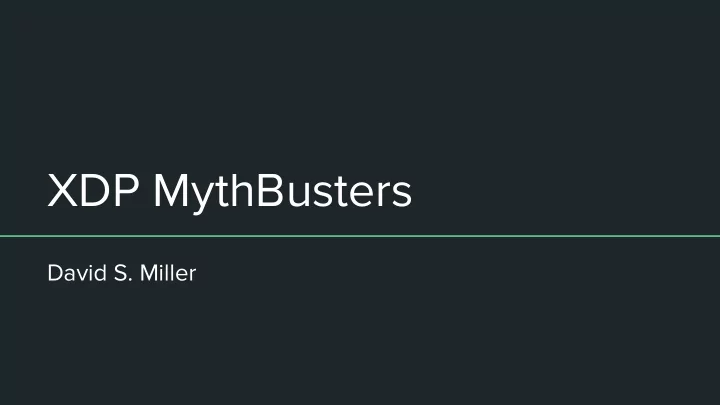

XDP MythBusters David S. Miller
Overview What is eBPF and XDP Why is it an important long term solution to a problem space Frequently communicated myths and inaccuracies Things that are true now but will not be true for long An epiphany on eBPF/XDP workflow
What Is eBPF? Van Jacobson and Steven McCane back in 1992 saw that at least some part of the kernel needed to be programmable Result was classical BPF, built specifically for simple packet filtering Full programmability requires something closer to a real CPU instruction set Result was an extension to classical BPF, called eBPF Full compilers exist from C and other languages into eBPF eBPF also has “maps” or formal data structures (no loops!)
What Is XDP? One of many applications of eBPF Runs eBPF programs at the moment the driver receives a packet XDP programs trigger actions using return codes XDP_DROP, XDP_TX, XDP_PASS, etc… XDP programs can modify packet contents XDP programs can push and pull headers
Why is XDP Fast? No dynamically allocated metadata Memory allocation is a significant transactional cost of packet processing So we just eliminate it XDP is given only the start and end pointers of the packet area XDP deals only with linear packet data XDP has no implicit dependency on state
XDP Problem Spaces Various forms of DDoS protection Block by source address and other more sophisticated matches Load balancing via the XDP_TX return code Custom statistics Sophisticated traffic sampling via perf events High speed trading platforms...
Advantages Of This Approach It is inside the kernel, therefore fully integrated with the rest of the networking We can specifically choose to give XDP programs access to objects and tables Via helpers and eBPF maps XDP programs always execute in finite time, no looping Strictly bounded execution time
eBPF/XDP Myth List This section requires audience participation If the slide asks a question, you must all answer after I read the question The appropriate answer is always “Noooooooooooooo……” Let’s do a test run, OK?
Can XDP slice bread? “Noooooooooooooooooooooooooo…….”
Is XDP just a fad?
XDP Is A Long Term Architectural Solution It is specifically designed to properly weigh several different needs High performance Full programmability Kernel integration Safety
Is XDP unsafe?
XDP Is No Less Safe Than Userspace The eBPF verifier protects us from rogue eBPF programs Kernel code implementing user processes and VM protection protects us from rogue userland programs THERE IS NO DIFFERENCE So if you argue “userland is safer” be honest with yourself that you just feel more comfortable with userland doing things And that this is a purely emotional position rather than a factual one
Is XDP less flexible than DPDK?
DPDK Lives Behind the Wall of Userspace DPDK’s greatest weakness is exactly that it is not integrated into the kernel XDP’s full kernel integration means that kernel objects are accessible DPDK’s container story →
Is XDP a replacement for netfilter, tc, etc.?
XDP Targets Specific Kinds of Use Cases XDP is not a Jack of all Trades: It provides high speed packet operations Flexible policy decision making And for this power there is a cost There are things it cannot do Is there some overlap between netfilter, tc, and XDP? The appropriate answer is: YES
Things Which Are Changing, Moving Forward Introspection (fetching installed XDP programs) Debugging (dwarf2 is too complicated, looking at CTF) Once we have debugging, attaching debugging info to maps and perf events Tracing XDP programs using perf events More consistent and friendly tooling
Development Using Arduino As A Model One day I had an epiphany… Arduino has defined entry points, helper functions, etc. You compile and “push” programs into the execution environment to run This is exactly the same as writing XDP programs The workflow is identical
Thank You Linus Torvalds Van Jacobson Alexei Starovoitov and Daniel Borkmann Thomas Graf and Tom Herbert Intel, Mellanox, and Netronome driver developers Jamal Hadi Salim
Recommend
More recommend